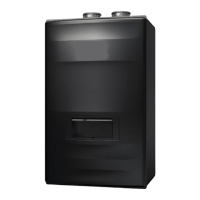22
LP-542 REV. 6.2.16
B. APPROVED VENT MATERIALS
Consult Table 9 or the most recent edition of ANSI Z223.1/NFPA 54 or CAN/CGA B149.1 as well as all applicable local codes and
regulations when selecting vent pipe materials.
APPROVED EXHAUST VENT AND INTAKE PIPE MATERIAL
Standards for Installation in:
Exhaust vent or Intake
pipe and fittings
PP, CPVC, and PVC venting must be
ULC-S636 Certified. IPEX is an approved
manufacturer in Canada, supplying vent
material listed to ULC-S636.
Certified for Category IV and
direct vent appliance venting
Certified for Category IV and direct vent
appliance venting
IPEX System 636 Cements & Primers
The exhaust and intake components installed with this water heater must be used for near water heater piping BEFORE
transitioning to the approved materials listed above. DO NOT REMOVE these installed components. Doing so WILL VOID
warranty.
PVC/CPVC pipe and fittings of the same diameter are considered interchangeable.
Use of cellular core pipe PVC (ASTM F891), cellular core CPVC, or Radel® (polyphenysulfone) in nonmetallic venting systems
is prohibited.
DO NOT connect PVC/CPVC to PP without an approved vent connector.
When installing AL29-4C vent piping, install a PVC-to-stainless adapter at the water heater vent connection, and at the
termination when using an HTP PVC termination kit. DO NOT mix AL29-4C piping from different manufacturers unless using
adapters specifically designed for the purpose by the manufacturer.
Covering non-metallic vent pipe and fittings with thermal insulation is prohibited.
DO NOT obstruct the flow of combustion or ventilation air.
When using Pipe Cement/Primer, follow the instructions included with the Cement/Primer closely. Clean and dry all applicable
surfaces before applying.
Failure to follow these directions will result in substantial property damage, severe personal injury, or death.
Table 9 – Approved Venting Materials
Vent adaptors are not designed as load-bearing devices, and must not be used to support exhaust vent piping. All vent pipes must be
properly connected, supported, and the exhaust must be pitched a minimum of ¼” per foot back to the boiler to allow drainage of
condensate. Failure to properly support vent piping and follow the information in this statement could result in product damage, severe
personal injury, or death.
High heat sources (sources generating heat 100
o
F / 37
o
C or greater, such as stove pipes, space heaters, etc.) may damage plastic
components of the boiler as well as plastic vent pipe materials. Such damages ARE NOT covered by warranty. It is recommended to
keep a minimum clearance of 8” from high heat sources. Observe heat source manufacturer instructions, as well as local, state,
provincial, and national codes, laws, regulations and ordinances when installing this boiler and related components near high heat
sources.
C. ALLOWED COMBINED VENT LENGTHS
Table 10 – Approved Vent Lengths
NOTE: When using more than 1 elbow, reduce maximum allowable length:
5 feet (1.5M) for each additional 3” 90
o
elbow
2.5 feet (.75M) for each additional 3” 45
o
elbow
8 feet (2.4M) for each additional 2” 90
o
elbow
4 feet (1.2M) for each additional 2” 45
o
elbow

